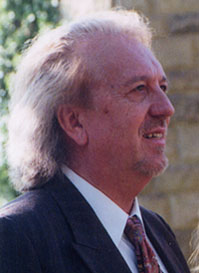DVD „Vidor Nagy in concert“
In the beginning was the audience arid it was infinitely curious. The muses saw that it was good, and that only in this manner could the arts flourish. They weren’t satisfied by Hamlet’s „To be or not to be“ declamation. The people wanted to know what the last article was which Hamlet had read; they didn’t believe that he was the creator of his own famous words. For the violist it’s not a given that his construct can be delivered in such a stroke of genius; the materials at his disposal are not sufficiently varied.
While the walls of his building: Bach, Mozart, Beethoven, Brahms, Hindemith, Bartók – are, indeed, made of precious timbers, they are in reality single luxury planks through which the winds of lack whistle. Consequently, combining a good dose of fantasy with practical ideas, the violist is involved in a constant renewal process, filling in the gaps of his little repertoire abode. Though this process demands of him both strength and energy, seeing his musical path illuminated in the evening glow, he is grateful for the daylight which, on the basis of existing and laboriously expanded materials, has enabled him to produce a synthesis of head and heart for such a long period of time. It is in the music he plays that the musician finds his sense of home.
Yet a piece of music is never finished; it’s in a constant state of renewal, reflecting the changing times, tastes and styles which remain facets of the creative process, That fact explains why the attempt to present such a work of art can almost be suicidal: all is revealed and one can only hope that the entire endeavor ends well. The analytical dialogue with mainstay repertoire – those pieces which enjoy the label „immortal“ – is never ending, as is the work on the performance of them. It is similar to the story of the Zen master who tormented his Student for seven years until, no longer able to endure it, behind his back he attempts to slay the Master. However, quick as lightning the Master turns around, interrupts the attempt and scolds: „Now the lessons can begin.“
It is similar to the life of a musician dramatically trudging through the tonal fields of his stubborn, yet so beloved, instrument. It is when the musician matures and has learned in considering „timeless“ compositions, one naturally questions his own ability to do justice to that work. We’ve already mentioned what the musician is faced with, yet he still has to fight like Sisyphus, even if – ultimately – it is only the joy of that fight which remains. Here, too, a parallel comes to mind: basket-weaving in an insane asylum. Also in music, goal and therapy are united in the striving itself. Along these lines, concerts and resulting tonal documentaries can be truer to life than life itself.
In now presenting a music video, l seek a path in a new world where that which has already been experienced might be re-awakened by colorful, kaleidoscopic traits. The normal chronological program order is being abandoned in favor of a larger dramaturgic construction with its own inner logic becoming apparent to the listeners, without threatening the Tower of Babel. The presence of an audience inspires, clears the throat, strengthens the breath and renews the lung. An audience is the most valuable resonating body into which an instrumentalist can be incorporated! Some artists, such as did the famous Maria Callas, even succeed in abducting their listeners to other planets, where the deepest melancholy, sensuality and dream appear to be the unlimited, life-affirming realities. Rilke maintained that music elevated him, only to let him descend even deeper in the aftermath. Nonetheless, it is known that whether in reality or in the world of the arts, provocation in the guise of beauty can ultimately have a positive effect. Beauty can be a drug. A wonderfully sung melody can work like a mystery; the measure of the artist is in the degree to which he harbors this secret within himself. The catharsis, the renewal and the illumination is then his.
Dino De Laurentiis was of the opinion, it all depends on the three C’s cuore – cervello – coglioni. That’s „just“ the language of a film producer, but certain musicians think likewise. The greatest of them would avoid that specific choice of words, but Pablo Casals meant the same in melding the musical idea with the element, water: “Rhythm is like waves in the river.”
Vidor Nagy 2008
